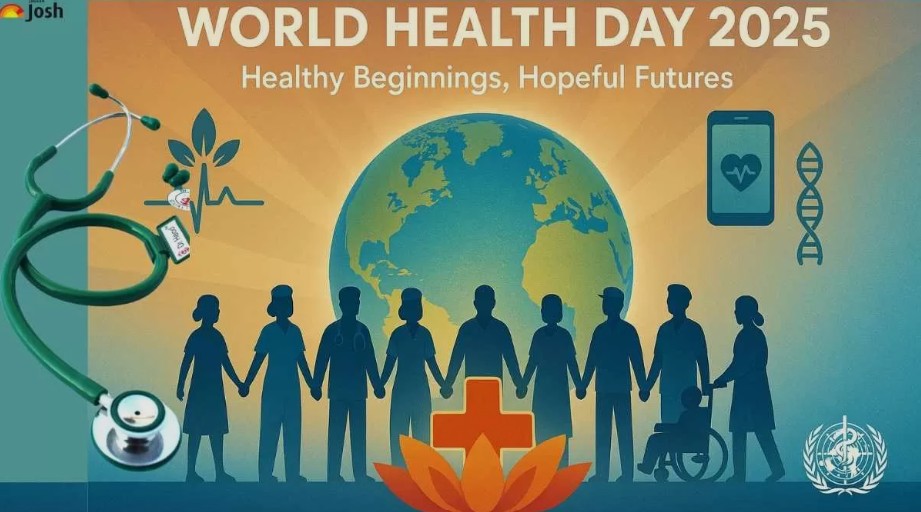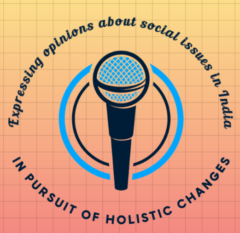Bridging Gaps, Building Futures

World Health Day 2025 marks a pivotal moment for India’s healthcare journey. With the theme “Healthy Beginnings, Hopeful Futures,” the nation is doubling down on equitable access to quality care. From maternal health advancements to digital innovations, India is rewriting its health narrative. Let’s explore how policies like Ayushman Bharat are driving progress—and what challenges remain. India’s commitment to health equity is evident in its efforts to strengthen rural healthcare infrastructure and expand digital health services. This year’s focus on maternal and child health underscores the importance of early interventions in shaping healthier futures.
Historically, World Health Day has been instrumental in raising awareness about critical health issues. India has leveraged this platform to combat polio, tuberculosis, and maternal mortality. Over 75 years, the day has catalyzed awareness, policy shifts, and grassroots action. The National Health Mission (NHM), launched in 2005, is a testament to India’s resilience in addressing public health challenges. As PM Modi stated, “Good health is the foundation of every thriving society.” This ethos drives initiatives like Ayushman Bharat, aligning with World Health Day 2025’s equity focus. Furthermore, India’s progress in reducing maternal mortality rates highlights the effectiveness of targeted interventions.
World Health Day 2025: A Legacy of Global Health
World Health Day, established in 1950, unites nations to address urgent health priorities. Moreover, the integration of traditional medicine systems with modern healthcare practices is being explored to enhance holistic care. By focusing on preventive care and early interventions, India aims to reduce the burden of lifestyle diseases and improve health outcomes across all demographics.
The theme of World Health Day 2025 emphasizes the need for collective action to ensure that every individual has access to quality healthcare. This aligns with India’s vision of achieving universal health coverage through programs like Ayushman Bharat. Additionally, the role of digital health platforms in expanding access to healthcare services is becoming increasingly critical. As Dr. Harsh Vardhan noted, “Digital health is no longer an option; it’s a necessity.” This perspective underscores the importance of integrating technology into public health systems to bridge urban-rural divides.
World Health Day 2025: Maternal Health Milestones
India’s Maternal Mortality Ratio (MMR) fell by 83% since 1990, reaching 97 per 100,000 births in 2020. Programs like Janani Suraksha Yojana incentivized institutional deliveries, while Maternity Waiting Homes reduced rural maternal deaths. Yet, neonatal mortality remains high at 20 per 1,000 births. The Maternal Death Surveillance and Response (MDSR) system identifies gaps, enabling targeted interventions. World Health Day 2025 emphasizes scaling such models to ensure “healthy beginnings” for all. Furthermore, the expansion of community health worker programs has been instrumental in improving maternal care in rural areas.
The success of maternal health initiatives in India can be attributed to a combination of government policies and community engagement. The MDSR system, for instance, has helped in identifying and addressing the causes of maternal deaths, leading to more effective interventions. Additionally, the role of ASHA workers in promoting institutional deliveries and providing prenatal care has been pivotal, even though they rarely get their due. In this context it has to be noted that the Kerala ASHA Health Workers Association (KAHWA) members have been protesting outside the Secretariat for 57 consecutive days, demanding retirement benefits and a higher honorarium. As India continues to focus on reducing neonatal mortality, integrating digital health tools to monitor pregnancies and provide timely interventions will be crucial. This aligns with the broader vision of World Health Day 2025 to ensure equitable access to healthcare services.
Ayushman Bharat: Bridging the Equity Gap
Launched in 2018, Ayushman Bharat covers 55 crore Indians with ₹5 lakh annual insurance. Over 31,846 hospitals are empaneled, authorizing 8.5 crore admissions by 2024. This scheme has saved families ₹1,800 crores during COVID-19. However, rural areas still face specialist shortages. Expanding Ayushman Arogya Mandirs (1.76 lakh centers) and telemedicine (e-Sanjeevani’s 36 crore consultations) is critical. World Health Day 2025 underscores digital integration to bridge urban-rural divides. Moreover, the integration of Ayushman Bharat with digital health platforms is enhancing the accessibility of healthcare services.
Ayushman Bharat has been a game-changer in providing financial protection to vulnerable families. The scheme’s success can be measured by the number of hospitalizations covered and the financial savings for families. However, challenges persist, particularly in ensuring that quality care is accessible in rural areas. The government’s focus on expanding telemedicine services through platforms like e-Sanjeevani has been instrumental in addressing these gaps. As Dr. Soumya Swaminathan noted, “Health equity is not just a moral imperative; it’s an economic necessity.” This perspective highlights the importance of initiatives like Ayushman Bharat in achieving health equity.
Digital Health: India’s Tech-Driven Transformation
The Ayushman Bharat Digital Mission (ABDM) linked 76 crore ABHA health accounts by 2025. U-WIN tracks 7.9 crore vaccinations, while Tele-MANAS handles 20 lakh mental health calls. Such tools democratize access, especially in remote regions. Challenges like low digital literacy persist. “Digital health is no longer an option; it’s a necessity,” says Dr. Harsh Vardhan. Investing in rural broadband and training ASHA workers can maximize ABDM’s impact, aligning with World Health Day 2025’s equity vision. Furthermore, the integration of digital health platforms with existing healthcare systems is crucial for seamless service delivery.
The digital transformation in healthcare is revolutionizing how services are delivered and accessed. Platforms like e-Sanjeevani have made telemedicine a reality for millions, reducing the need for physical visits to hospitals. The U-WIN platform ensures timely vaccinations, which is critical for preventing infectious diseases. Moreover, the use of data analytics in ABDM helps in planning and resource allocation, ensuring that healthcare resources are utilized efficiently. As India continues to expand its digital health infrastructure, addressing issues like cybersecurity and data privacy will be essential.
Lifestyle Diseases: A Silent Epidemic
Over 440 million Indians may face obesity by 2050. Diabetes and hypertension screenings at Ayushman centers (107 crore tests) highlight preventive efforts. The Fit India Movement and sugar taxes aim to curb unhealthy trends. Urbanization and sedentary habits fuel this crisis. World Health Day 2025 urges campaigns to promote nutrition and physical activity. Public-private partnerships can scale solutions, ensuring healthier futures. Additionally, integrating nutrition education into school curricula can help in shaping healthier habits from an early age.
The rise of lifestyle diseases poses a significant challenge to India’s healthcare system. While preventive measures like screenings and awareness campaigns are underway, more needs to be done to address the root causes of these diseases. Promoting physical activity through initiatives like the Fit India Movement is crucial. Moreover, collaborations between government agencies, NGOs, and private sector entities can help in scaling up preventive healthcare programs. As Dr. K. Srinath Reddy noted, “Prevention is better than cure, especially for lifestyle diseases.” This underscores the importance of proactive measures in reducing the burden of these conditions.
Mental Health: Breaking the Stigma
Depression affects 56 million Indians yearly. Tele-MANAS and 440 rehab homes offer hope, yet awareness gaps persist. NHM’s focus on workplace wellness and community counseling is vital. “Mental health is inseparable from physical health,” asserts Dr. Soumya Swaminathan. Integrating mental care into primary health systems, as World Health Day 2025 advocates, can transform lives. Furthermore, reducing stigma around mental health issues is essential for encouraging individuals to seek help.
Mental health has become a pressing concern in India, with a growing need for accessible services. The Tele-MANAS initiative has been instrumental in providing teleconsultations, making mental health support more accessible. However, there is a need for more community-based programs to address the social determinants of mental health. Integrating mental health services into primary care systems can help in early detection and treatment. As India continues to expand its mental health infrastructure, ensuring that services are culturally sensitive and accessible will be crucial.
Holistic Solutions for a Healthier India
To achieve health equity by 2030:
- Boost health spending from 1.5% to 3% of GDP.
- Train rural health workers in digital tools and emergencies.
- Merge Ayurveda with modern medicine for holistic care.
- Scale preventive campaigns targeting obesity and diabetes.
- Strengthen public-private partnerships for last-mile delivery.
Moreover, promoting health literacy among the public can empower individuals to make informed decisions about their health. This aligns with the broader vision of World Health Day 2025 to ensure that health services reach every corner of the country.
Achieving holistic health in India requires a multifaceted approach that addresses both physical and mental well-being. By integrating traditional medicine systems with modern healthcare practices, India can offer more comprehensive care options. Additionally, scaling up preventive healthcare programs through public-private partnerships can help in reducing the burden of lifestyle diseases. As India moves forward, ensuring that healthcare services are accessible, affordable, and equitable will be essential for building a healthier society. This vision aligns with the theme of World Health Day 2025, emphasizing the importance of collective action in achieving health equity.
Conclusion: Equity as the Cornerstone
World Health Day 2025 reminds us that health is a right, not a privilege. India’s strides in maternal care, digital health, and Ayushman Bharat are commendable. Yet, systemic gaps demand urgent action. By prioritizing equity, innovation, and inclusivity, India can ensure “hopeful futures” for every citizen. “A healthy India is a prosperous India.” – PM Narendra Modi. Let’s unite to make this vision a reality. As we celebrate World Health Day 2025, we must commit to holistic solutions that integrate healthcare with social determinants, ensuring that every individual has access to quality care.
The journey toward achieving universal health coverage in India is ongoing, with World Health Day 2025 serving as a reminder of the progress made and the challenges ahead. By focusing on equity and innovation, India can bridge the gaps in its healthcare system. The integration of digital health platforms, expansion of Ayushman Bharat, and emphasis on preventive care are all steps in the right direction. As India continues to evolve its healthcare landscape, ensuring that services are accessible, affordable, and equitable will be crucial for building a healthier society.
Call to Action: Share this blog! Tag #WorldHealthDay2025, #HealthEquity, and #AyushmanBharat to spread awareness!
